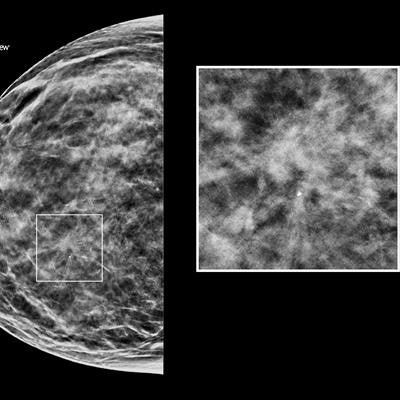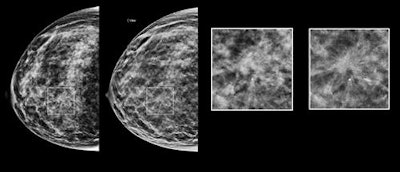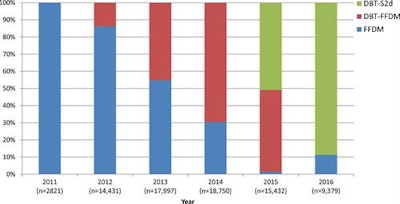
A new study published February 21 in Radiology should put to rest any fears about the suitability of synthesized 2D digital breast tomosynthesis (DBT) for breast screening. Researchers who used the technology to screen more than 16,000 women found it had lower recall rates with no compromise in cancer detection.
The team from Graham Cancer Center at Christiana Care Health System in Delaware compared the performance of synthesized 2D DBT for breast screening with that of two other techniques -- conventional DBT with full-field digital mammography (DBT-FFDM) and FFDM alone -- in a population of nearly 79,000 women seen over five years at its community center. Synthesized 2D DBT had a recall rate of 4.3%, compared with 5.8% for the DBT-FFDM combo, and there was no statistically significant difference in cancer detection rates (Radiology, February 21, 2017).
The findings led the group to conclude that synthesized DBT was completely suitable for breast screening.
"The adoption of (synthesized 2D DBT) mammography combined with DBT into screening programs would limit radiation exposure to the patient, and, on the basis of our results, may improve clinical performance compared with that of DBT-FFDM," the authors wrote.
 A synthesized 2D DBT image. Image courtesy of Hologic.
A synthesized 2D DBT image. Image courtesy of Hologic.The latest advancement
Synthesized 2D DBT is the latest advancement in digital breast imaging. It was developed to address a shortcoming when conventional DBT is used for screening: the need to obtain a 2D FFDM exam to go along with a 3D DBT study. While the additional radiation dose from such combo studies is below U.S. Food and Drug Administration (FDA) guidelines for breast screening, the exposure is still 39% to 45% above that of a single FFDM screening exam.
Vendors therefore have developed software techniques capable of producing a synthesized 2D image from 3D DBT data. In 2013, the FDA approved a version of synthesized 2D software (C-View, Hologic) designed to be used as an adjunct to DBT for breast cancer screening rather than FFDM. Shortly thereafter, a number of breast centers around the U.S. that were using DBT-FFDM for screening began switching to the synthesized 2D DBT option.
The Graham Cancer Center has consistently upgraded its mammography technology over the years, giving the facility experience with multiple types of breast imaging technologies. The practice began using DBT in September 2012, but staff found that concerns about the higher radiation dose needed for the 2D FFDM image to accompany DBT impeded broader use for screening, according to Dr. Jacqueline Holt, senior author on the new study.
"The downside was that while the dose was well within FDA standards, it got us back to where we had been with screen-film mammography in terms of dose," she said.
Therefore, when synthesized 2D DBT became available, the center embraced its use for screening, starting in June 2015. To ease the transition, for a three-month period it performed both synthesized 2D DBT and DBT-FFDM.
Early research studies from other sites have demonstrated positive clinical results for synthesized 2D DBT. For example, a study by Zuckerman et al presented at RSNA 2015 and published in the December 2016 edition of Radiology found a lower recall rate for synthesized 2D DBT than DBT-FFDM (7.1% and 8.8%, respectively). That study found no statistically significant difference in the cancer detection rate.
The researchers at Graham Cancer Center therefore decided to perform their own study, using their experience with synthesized 2D DBT in a large community-based screening center, Holt said. While the Zuckerman et al study had data from about 5,000 synthesized 2D DBT screening exams, the Graham researchers had access to data from more than 16,000 synthesized studies.
"We had to see how we were doing as an institution," Holt told AuntMinnie.com. "We knew we were doing the right thing regarding the dose, but we wanted to check on ourselves."
The researchers first tracked the shift from FFDM to DBT-FFDM and then synthesized 2D DBT (DBT-S2d), as shown in the chart below, which tracks mammography exams performed by type of equipment. Over time, the share of DBT-FFDM grew as conventional FFDM shrank; in the past two years, synthesized 2D DBT took over the lion's share of studies.

But how well did synthesized 2D DBT perform clinically compared to the other technologies? The researchers decided to answer this question by analyzing each of the three modalities for their performance across major clinical parameters, including cancer detection rate, recall rate, number of biopsies recommended and performed, false positives, and other categories.
A total of 78,810 mammograms were acquired over the study period from 2011 to 2016, consisting of 32,076 FFDM, 30,561 DBT-FFDM, and 16,173 synthesized 2D DBT.
As with the Zuckerman study, the Graham Cancer Center team found that recall rates were lower for synthesized 2D DBT on a statistically significant basis, while there was no statistically significant difference in cancer detection rate. The percentage of invasive cancers detected was higher with the synthesized technique, while other parameters also showed improvement.
| Comparison of synthesized 2D DBT, FFDM, and DBT-FFDM | ||||
| FFDM | DBT-FFDM | DBT-S2d | p-value | |
| Cancer detection rate | 5.3 cancers /1,000 exams | 6.4 cancers/1,000 exams | 6.1 cancers/1,000 exams | 0.08-0.27 |
| Recall rate | 8.7% | 5.8% | 4.3% | < 0.0001 |
| False-positive rate | 8.2% | 5.2% | 3.6% | < 0.001 |
| Invasive cancers detected | -- | 61.3% | 76.5% | 0.01 |
| Positive predictive value | -- | 28.5% | 40.8% | < 0.001 |
The researchers were "pleasantly surprised" by how well they performed using synthesized 2D DBT, Holt said. The synthesized images look different than conventional FFDM mammography, with an appearance that Holt characterized as having more contrast. But radiologists at the Graham Cancer Center are converts to the technology after seeing their numbers improve.
"The proof is in the pudding," she added.
How to implement synthesized 2D DBT
Holt said she's heard from colleagues at nearby breast centers who are reticent to commit to screening with synthesized 2D DBT until more research is in, but she believes that the current study and the Zuckerman research indicate the technology is ready for routine use.
What's more, she thinks that screening with synthesized 2D DBT will address some of the criticisms of mammography screening that have been levied by critics who tout "risks" such as workup after callbacks and breast biopsies.
"We've decreased the 'risks' of callbacks and biopsies and saved healthcare dollars without apparently affecting our cancer detection rate, while potentially finding more lethal cancers," Holt concluded. "This is a practice changer."



















